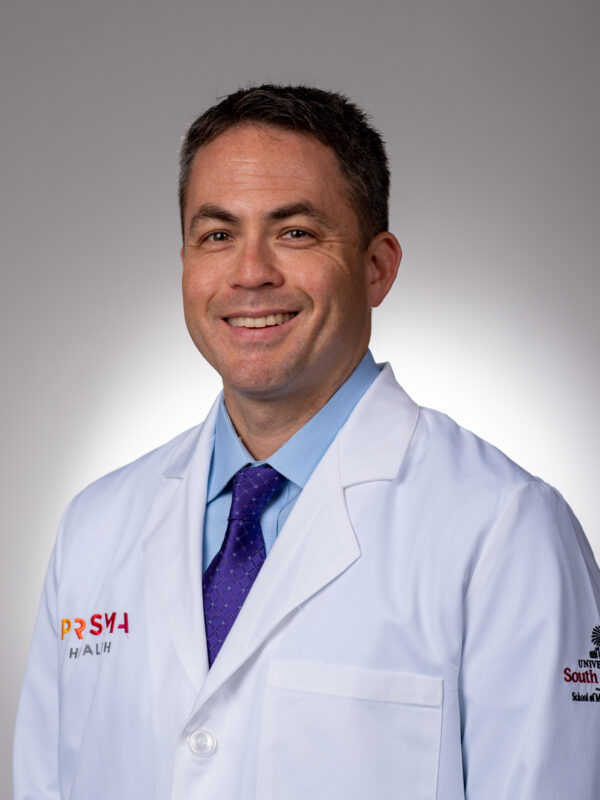5 fast facts about mouth cancer
Mouth cancer, also known as oral cavity cancer, can affect anywhere within the mouth, including the tongue, the gums, the back of the mouth where it becomes the throat, upper and lower lips and the inside of the cheeks. Oral cavity cancers can spread quickly, so it’s important to know what to watch for and be aware of your risks.
Head and neck surgeon Jeff Jorgensen, MD, offered five fast facts about mouth cancer and advice on how to lower your risk.
1. The symptoms might not be that obvious
“The most common symptoms of mouth cancer are pain that worsens with moving the tongue or sore spots or ulcerations inside the mouth,” said Dr. Jorgensen. “However, there are some other notable symptoms that are less well known.”
In some cases, people with mouth cancer may experience ear pain, unexplained weight loss, painful or loose teeth, a white or reddish patch inside the mouth, difficulty breathing or difficulty swallowing.
2. Mouth cancer is often caused by squamous cell carcinoma
Squamous cell carcinoma is a common form of skin cancer, but it’s also the most common type of mouth cancer. The cells that line your lips and the inside of your mouth are called squamous cells, and as that’s where this kind of cancer begins, that’s where it takes its name.
3. Diagnosis involves the use of a telescope
“The initial evaluation, performed by an ENT physician during an office visit, is going to be very thorough and take a look at your head and neck, including the back of the tongue and the oral cavity,” said Dr. Jorgensen. “For these examinations, we use a procedure called a flexible fiberoptic laryngoscopy.”
A flexible fiberoptic laryngoscopy takes a small telescope that is passed through the nose and into the throat. This way, your surgeon can evaluate not just the initial space within your mouth but also the back of the mouth, into the throat and down to the voice box to look for lesions that might be of concern. During this exam, numbing spray is used to keep discomfort to a minimum.
Any concerning lesions will be biopsied to confirm a potential diagnosis, and additional imaging of the neck and chest is performed to determine the extent of the cancer’s development.
4. Newer surgical treatments have lower recovery times and high levels of success
Surgical removal of the cancerous lesion remains the gold standard initial treatment for mouth cancer, with the extent of the surgery depending on where the cancer is located and how much it has developed. Some patients may be good candidates for a newer surgical procedure called transoral robotic surgery, or TORS.
TORS relies on a computer system that helps to guide surgical tools used by the ENT surgeon, with the tools passing through the mouth to access the throat if needed. The robotic system helps the surgeon make more precise movements in small and awkward spaces within the mouth, work around corners and get a better view of the cancer itself and the tissue around it. Compared to the standard treatments used in past years, TORS has shorter recovery times and lower rates of complications for patients.
Radiation or chemotherapy may also be needed.
5. Risk factors include tobacco use – yes, even vaping
While mouth cancer can’t be totally prevented, knowing your possible risk factors can help you take steps to lessen your chance of developing oral cavity cancer. Risk factors for mouth cancer include:
- Heavy use of alcohol
- Extensive sun exposure to your lips
- Becoming infected with the human papillomavirus, or HPV
- A weakened immune system
- Use of tobacco products like cigarettes, cigars, pipes, chewing tobacco and snuff
- Vaping, or the use of e-cigarettes
To lower your risk for mouth cancer, stop using tobacco products if you ever have. Even if you’ve been smoking or using tobacco for years, quitting now can still help you lessen your risk factors for cancer! Take care to use sunscreen even on your lips and around your mouth of at least SPF 30, broad spectrum, to protect against damage caused by the sun. Vaccination against HPV for younger individuals can help protect against the potential for oral cancer as well. Consume alcohol in moderation or enjoy non-alcoholic drinks instead.
Finally, be sure to make regular visits to your dentist for checkups and cleanings. In the event of a potentially concerning spot, your dentist may be the first to notice and help you get the medical care you need sooner.
Find a doctor
Whether you’re looking for a primary care physician or need to see a specialist, we’re here to help with experienced, compassionate care near you.
Find a Doctor

